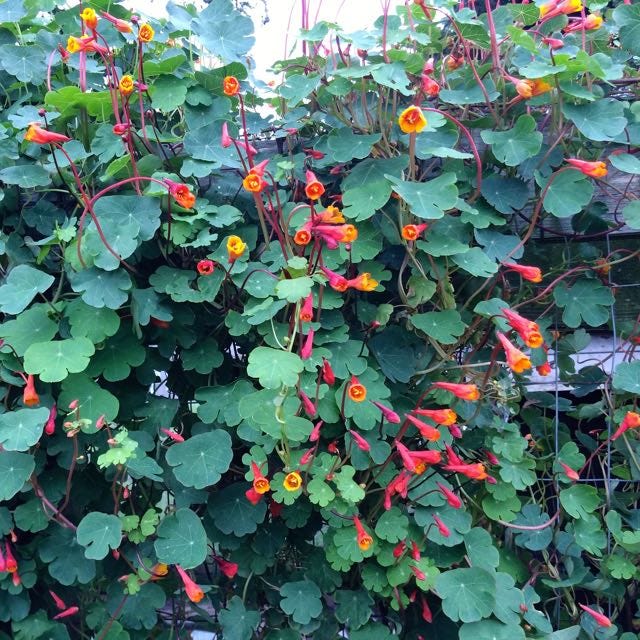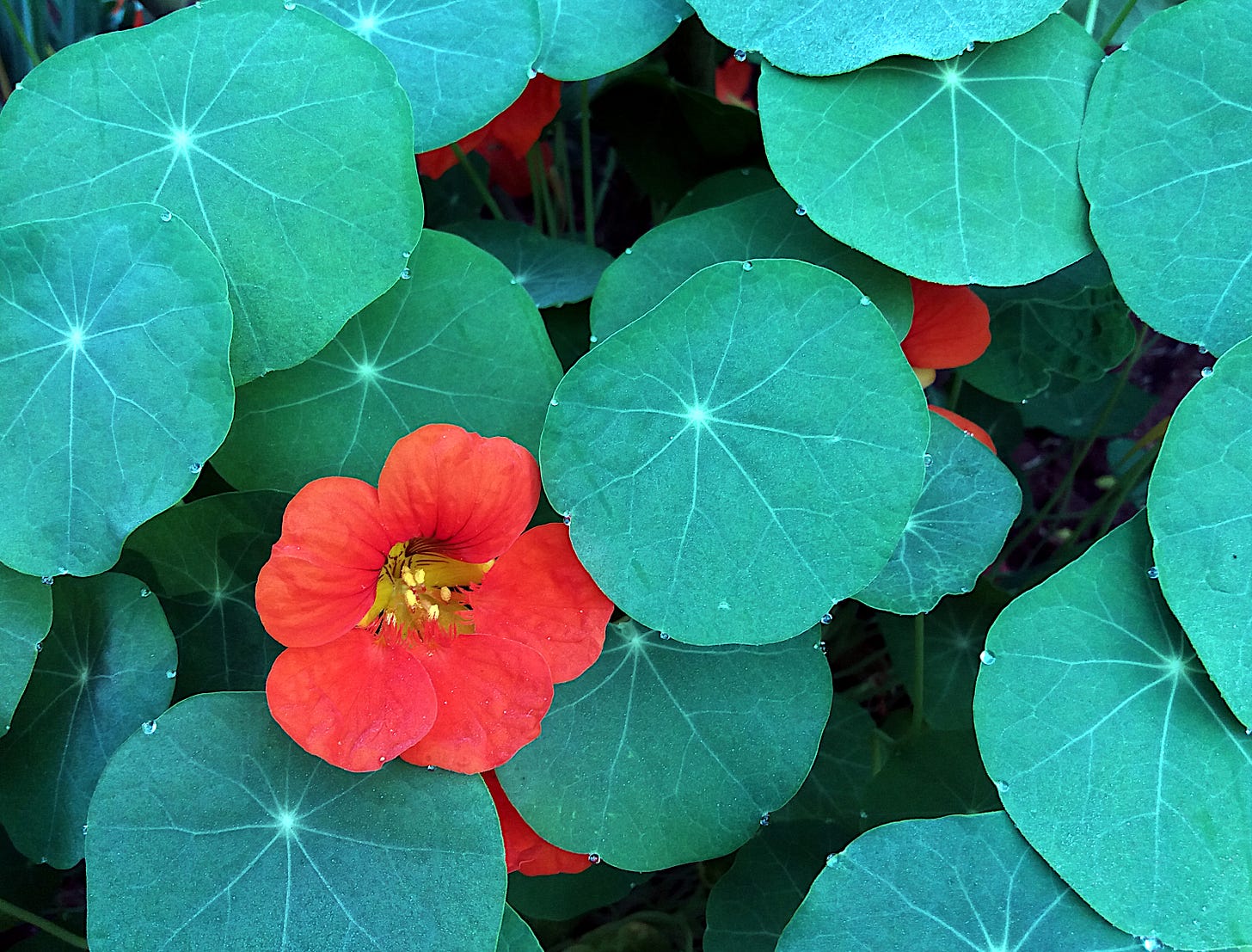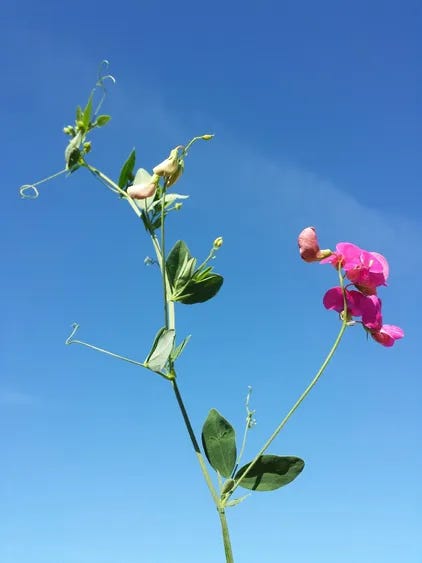ALSO KNOWN AS: mashwa (Ecuador and Peru), Tropaeolum tuberosum, maswallo, mazuko, mascho (Peru), cubio (in Colombia), mascho (Peru), añu (in Peru and Bolivia), isaño, tuberous nasturtium, papa amarga (bitter potato - there is another variety of potato that goes by this name.)
Not nasturtium, though they are related. Mashua has deeper scallops on its leaves.
Or tuberous pea that also grows on a vine with small vibrant flowers. Pea flowers are shallow and oval.
How to know
Soft semi circular leaves with deeply scalloped edges.
Flame colored, trumpet-shaped flowers
Long and thin reddish vines
Three to five leaves per stem

All lakes have lives, though much longer than our own. They will each dry out. Over thousands of years a lake forms, becomes a swamp, then a wetland, and then it is gone, leaving a nutrient rich landscape behind. This process is not something to be mourned, it’s part of a primordial dance.
Water and climate shifts during that length of time and the land, of course, changes too.
But the Titicaca lake that straddles Peru and Bolivia along the Andean mountain range is three million years old and is one among the small number of ancient lakes in the world. Titicaca is bean shaped and situated at a high altitude of 12,500 feet above sea level. At this height the climate ranges from cold at night to temperate during the day with summer rainy seasons and dry winters. You don’t have to look hard to see how important this place has been and still is to generations of people. It’s shores adorned by immaculately built stone structures and formations that were used in ceremony and every day life. This region’s ecological situation is woven into the religious beliefs of the place. This lake was the site and center of Incan spiritual and every day life. It is the sacred place where the sun was birthed according to Incan tradition.
In addition to shaping culture it has been an important shaper of a persistent strain of plants as well, some of which, like the potato, have traveled far from its native home and developed into a staple food among many cultures. Among them, is a plant known for its steadfast bitterness and subtle beauty among the locals, but none too common in the rest of the world. The mashua thrives in the cool tropical mountains of the Andes and is cultivated for various purposes from Peru up to Colombia.
In Incan tradition the mashua was looked over by the goddess of floral food and original mother, Mama Rayhuana. The mashua might have been her right hand. It is a well known plant, food stuff, and tool in the region is an emblem of the ecological feeling of the basin. The lake cools and slightly humidifies the air while the altitude makes oxygen thin, and weather varied. Resembling the variety of weather, their taste is not altogether sweet, but it is nutritious and their functions for humans are multifaceted. It is eaten and used as an assistant to more desirable, sweet, delectable crops. It is beautiful, and has been used as an ornamental plant. But, more than anything, it is celebrated for its consistency. Warriors would be a good comparison for them, not for their brazenness, nor their berserk tendencies, not for their sweet seduction, but for the mashua’s sheer numbers and dogged growth.
Many of the cultivars of this region resemble one another in the form of the oca, ulluco, and potato. You will know this plant as a wash of green. Vines sprawling and climbing in a light green ocean.
Their small vines can extend between 7-13 ft. The soft semi circular leaves are interrupted by deep lobes. Bursts of red and orange trumpet shaped flowers reveal its close relationship to nasturtiums. Their seeds can be used as food, but their roots are what truly distinguish their place in the local cuisine. They have scores of tubular roots fanning out below the ground. These plants, along with the wild potato, were cultivated about 8,000 years ago. With records about the plants nearly 14,000 years ago. Over that time the bitter taste has been maintained in them.
Their tubers are generally yellow or white, but can be red, orange, or purple with deep indents like prominent wrinkles all around. Depending on the pigmentation the roots have a varying range of minerals. These tubers (or underground stems) can grow up to 13” beneath the soil, and take a knobby, thick form. They generally look like small colorful potatoes. And they are eaten in the same way: sautéed or baked. Orange trumpet flowers with long spurs at the end which are pollinated primarily by hummingbirds.
The Tropaeolaceae family, of which mashua is one, includes about 100 species. They are known for their delicate stems and soft, lobed leaves and their starchy roots.
Mashua grows well in marginal soils, competing with any aggressive plant. Adapted to high altitudes and can survive in partial sun or full sun. So it’s resistant to a range of weather conditions. But for how resistant this plant is, it does not like to leave cool mountain ranges. And in the United States it struggles to grow anywhere but the cool, high altitude, and rainy Pacific Northwest.
Although mashua is fully domesticated, it can persist in wild vegetation because of its aggressive growth and robustness. However, even though it can outcompete the most pervasive weed, the issue of human selection makes this plant vulnerable, simply, in a massively globalized society, one which affects the plant life regardless of region, this plant is not currently recognized on the global scale, thus vulnerable in the face of the potato.
Plants like this underline the importance of continuing ancestral practices around food. The cultivation of mashua will give it the the opportunity to adapt in a changing climate, and transform in the context of a changing floral ecosystem.
In addition to being a food, mashua is prized as a companion crop used for intercropping. The bitter taste makes it resistant to pests who avoid the bed altogether. They are bitter and this tastes permeates even when it is tamped down by pounding, freezing, and cooking. It’s peppery and sharp in taste, like a turnip. But small, even sharper than that.
Vitamin C and Vitamin A as well as protein and amino acids are present in the root. As a medicine, mashua heals topical wounds. An oil derived from the plant has been used to treat kidney and liver diseases. It also lowers testosterone and has a reputation as an anaphrodisiac. They were given to Incan troops so they would forget their wives. Due to the presence of isothiocyanates Mashua contains Docosahexaenoyl Ethanolamide, which elicits an endocannabinoid (a cannabinoid created by the body) that helps with homeostasis, and regulating our memory assisting in focus. No wonder these warriors forgot their wives from this old mountain root.
Myth for mashua
There was a man who wanted to be alone. Just like anyone in the region where he lived, he grew up in a small community. Some thought he was another being who had accidentally come out as a human. He was, in a way, like a caged bird, so he spent many days wandering alone.
Early one morning, before the sun rose, he returned home to find that a flood had destroyed his town and all the people were gone. All he found was a small note from his little sister. “We are in the mountains.”
So he continued up the mountain to find them. And as he walked he became what he truly was: long vine, connecting him to the whole mountainside. His feet remained in the soil where his village was, they dug into the soil The redness of his vine was his blood, that still-human part of him. The only difference was that he did not want to be alone anymore. As dawn rose it tinged his blooming flowers with the gold crimson colors of dawn. Where the mashua is rooted there is his old home. Its bitterness is the remnants of his loss. But he will never leave humanity again. He protects the plants that make up our food at home. Wherever mashua is, there he is making home. But he never leaves the mountainside because he is always looking for the dispersed community he lost long ago.
Forager Friendly?
Yes! If you find yourself in the Andes, take sparingly and with respect and consent of the community you are in. But these plants grow profusely.
Sources:
https://amp.theguardian.com/lifeandstyle/2021/oct/30/how-to-grow-mashua
https://whc.unesco.org/en/tentativelists/5080/
https://www.cultivariable.com/instructions/andean-roots-tubers/how-to-grow-mashua/#description
https://www.ncbi.nlm.nih.gov/pmc/articles/PMC3541447/
https://www.health.harvard.edu/blog/the-endocannabinoid-system-essential-and-mysterious-202108112569
https://onegreenworld.com/product/mashua/
https://www.sciencedirect.com/topics/agricultural-and-biological-sciences/tropaeolaceae
https://weadapt.org/knowledge-base/vulnerability/lake-titicaca-bolivia-climate-context/






